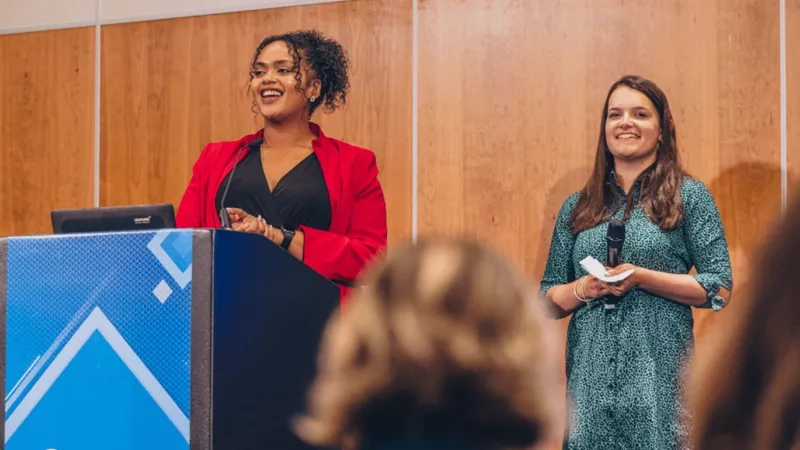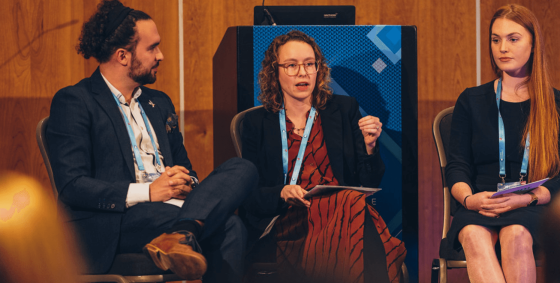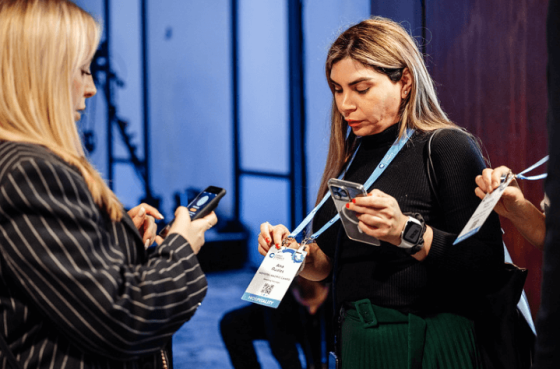Roadshows are series of live events held in different locations to showcase your brand, products, or services directly to your target audience. Different roadshow event types include interactive product demos, expert panels, pop-up experiences, and more.
If you’ve ever taken the same event from one city to the next, you already know what a roadshow event is, and if you haven’t, you’re probably wondering what it takes to plan one.
A roadshow is simple: you design one event and repeat it across multiple locations. You reach your audience where they live and work without expecting them to come to you.
More planners are also moving towards field marketing events. That’s partly because targeted, small events are on the rise: 27% of planners say they expect to see an increase in these kinds of events in 2025.
And it’s also because a roadshow makes sense.
With the proper setup, you can deliver the same hands‑on sessions, demos, and networking opportunities in every city without rebuilding the event every time. In this guide, we’ll look at what it is, share some roadshow event ideas, how to plan them, and practical ways to promote them.
What is a roadshow event?
A roadshow is what happens when you take one well‑planned program and repeat it in different places.
You put together the sessions once, demos, hands‑on time, and Q&A, and then run the same event in Chicago, London, or wherever your customers are. Each stop stays small so people can see your product up close and talk to your team without feeling like another face in a crowd.
Because you use the same agenda every time, you can focus on the basics, such as venues, tech, and timing, and not reinvent the wheel for every city.
8 great roadshow event ideas
Looking for inspiration for your next roadshow? Here are 8 creative and effective roadshow event ideas to help you stand out and connect with your audience.
1. Multisensory branding experiences
People remember what they feel. So, instead of telling your story through a static booth or slide deck, bring it to life. Some brands are now creating full sensory walk-throughs — complete with soundscapes, scent cues, tactile installations, and lighting effects — that fully immerse attendees in the brand experience. They are showing up in a way that sticks with attendees even after the event ends.
2. Interactive product demos
This one never gets old because experiencing tech in-person, hands-on, always trumps online demos. Give people the tools and space to experiment. Let them push buttons, test features, and even compete in product challenges. If your tool is built for speed, set up a timed race. If it’s for flexibility, invite people to make something with it on the spot. The more hands-on it is, the more likely it’ll click.
3. Behind-the-scenes tours
Pulling back the curtain builds trust. Whether it’s a look at your R&D lab, a preview of an unreleased product, or a walkthrough of how your support team solves problems, these moments feel real. People crave transparency, and roadshows are the perfect excuse to let them in on your process. It also turns customers into insiders, and insiders stick around.
4. Industry expert panels
You don’t need celebrity keynotes to deliver value. Often, the most powerful moments come from thoughtful conversations between people doing the work. Bring in customers, partners, or even competitors to share what’s working and what’s not. Set the stage, ask sharp questions, and let the panel take it from there. Done right, these discussions become the highlight of the stop.
5. Hands-on workshops
If someone’s showing up for a two-hour roadshow slot, make it count. Give them a skill. Workshops are great for this. Whether it's a technical masterclass, a use-case deep dive, or a strategy lab, people appreciate sessions that make them better at their jobs. Bonus points if it ties back directly to your product, but the focus should always be on helping them get smarter.
6. Networking events
Roadshows are usually about the community you’re building. So, it is essential to give people the space to meet each other. This doesn’t have to mean a formal mixer. It could be a breakout lounge with coffee, speed networking after a session, or a short happy hour at the end of the day. The key is to create places where your audience can talk shop with someone new.
7. Pop-up experiences
You don’t always need a ballroom or conference center. Some of the best roadshow moments happen in unexpected places. Think mobile showrooms parked outside office parks. Think pop-up lounges in coworking spaces. These setups catch people off guard (in a good way, of course) and let you meet them where they already are without asking them to give up a whole day.
8. Gamified activations
Turn engagement into a game by adding small challenges, scavenger hunts, or leaderboard-style contests that encourage exploration and participation. The goal is to make attendees enjoy the moment and also retain them for future events. People remember what they interacted with. And if they shared a laugh while doing it, even better.
How do you plan a roadshow event?
Planning a successful roadshow involves juggling many moving parts. These steps will help ensure your roadshow runs smoothly from start to finish.
Start with a repeatable format
When you plan a roadshow, you don’t want to rethink the whole thing every time you roll into a new city. The easiest way around that is to nail an agenda that works for every stop. Pick a style you can repeat — hands‑on demos, real Q&A with your team — so you can focus on making each visit feel like it’s just for them. It keeps you from scrambling, and it keeps the experience familiar no matter where you are.
Book spaces that fit
You don’t need a huge ballroom--just a space where people can see what you’re showing and engage in conversation without feeling rushed. Small venues work better because they make the event feel personal, and booking them early means you’re never worrying about finding a spot that’s already taken.
Get the logistics straight
A roadshow only feels smooth when someone has handled all the boring stuff before you leave. That means travel, shipping, and signage — all of it sorted early so you’re not stuck fixing problems between cities. The more you plan that part, the less you have to stress when you hit the ground.
Make tech work for you
You shouldn’t have to rebuild your registration or email workflows from scratch every time you hit a new city. Field marketing software like Cvent Essentials is made for this purpose. You set up your event once, including registration, confirmations, and follow-ups, and reuse that same structure across every stop. It’s built for repeatability, but not at the cost of quality.
You can create branded theme templates so every stop feels cohesive, even when different teams are running the show. The system captures data the same way each time, and its built-in compliance checks help you stay within your legal and organizational guardrails.
Work with local contacts
You don’t have to do it all on your own. When you take a show on the road, lean on someone local, such as a regional office, a partner, or even a customer who knows the area. That extra help means less guesswork and more real connections, especially when they can point you to a venue that suits your crowd.
Tailor the content to each city
Your core agenda can stay the same, but the examples you use don’t have to. Tweak a few details so each stop feels like it was built for that crowd. You could use a case study from someone nearby, have a guest speaker who understands local challenges, or do a demo that solves a problem they face. When people recognize their world in your content, they pay attention.
Get your team ready
Your team is the face of the event. Take a moment before you leave to review who’s attending and what they're interested in. This way, nobody feels blindsided if someone asks a question about local trends or challenges. Your team looks sharper and more prepared because they understand the audience.
Have a backup for everything
Something will go wrong. It almost always does. A flight might be delayed, a speaker might cancel last minute, or a demo might glitch.
So, come prepared for it. Keep an extra laptop charged, know who can jump in if a speaker drops out, and have a few extra hotel rooms booked just in case. If things go as planned, great! If they don’t, your plan B will save you, and most people never even notice that anything happened at all.
How to improve your roadshow marketing
Looking to make your next roadshow more impactful? Let's explore some proven strategies to take your roadshow marketing to the next level.
Promote your event early
You can’t spring a roadshow on people a week before you show up and expect them to drop everything. Get the dates, venues, and agenda up months before your first stop so they can plan around it.
After a few days, schedule your email reminders. Send an early-bird invite, a note when the agenda’s live, and a final push as the event gets close so nobody feels like they missed the chance to register.
Reach them where they are
Your event marketing doesn’t need to feel like a generic blast. Reach people in the places they already pay attention to — an email to your top customers, a post in the LinkedIn group they check, or a quick shout-out at a local meetup. When they see the invite where they normally hang out, they’re much more likely to read it and pass it along.
Give them a good reason to attend
People don’t come just because you’re there. Make sure they know what they’ll take away. It could be because of a hands‑on demo they can try themselves, a real conversation with someone who knows your product inside and out, or a sneak peek at what’s coming next. When they can picture leaving with something they’ll use, it’s easier to say yes.
Gather feedback
When you wrap up each roadshow, don’t let everyone scatter without hearing from them.
Send a quick follow-up thanking them for showing up and asking what they liked and what felt flat. It’s best to do this while the trip is still fresh in their minds. This feedback will tell you what to repeat and what to change for the next leg of the tour. When people feel heard, they’re more inclined to come back next time.
How do roadshows fit into your event marketing mix?
Roadshows can complement other event types and reach previously untapped audiences. Learn how integrating roadshows can create a more dynamic and effective event marketing mix.
Reach people who won’t travel
Big conferences and trade shows draw crowds, but not everyone can make the trip.
Roadshows help you go to them instead: smaller, micro events that make it easier for people to drop in without booking a flight or blocking off three days. That’s a real win if you want to connect with customers who’d never come to your main event.
Keep your message consistent
A roadshow is a chance to take the same message on tour without losing focus. Your team shares one story and repeats it at every stop. This consistency keeps everyone on the same page and ensures that customers in every city receive the full experience.
Fill the gaps in between big events
Your biggest conferences might happen once a year, but interest doesn’t wait for the calendar.
Roadshows let you stay present and visible in between, especially if you’re launching new features, pushing new products, or reaching new markets. That way, customers don’t have to wait months to catch up.
Deepen connections
When you take your event into smaller settings, the conversations feel different. People have more time to ask questions, you have more time to listen, and it’s easier to follow up after. That’s what turns a one‑off event into a long‑term relationship, and that’s why roadshows fit so well into a bigger plan.
Conclusion
A roadshow is about meeting your audience where they are, not making them come to you. It’s one repeatable format, deployed in the right cities, with just enough local touch to make each stop feel relevant.
A roadshow works if you want to stay top of mind between big conferences, reach people who won’t travel, and keep your message consistent. So, whether you're scaling your reach, staying visible between flagship events, or deepening relationships in new markets, a roadshow gives you the framework to do it well—and do it again.
Up next, read 14 innovative networking event ideas to try in your next event.










